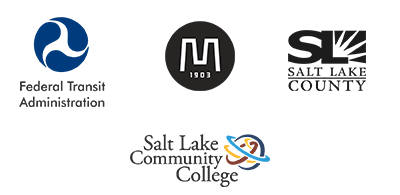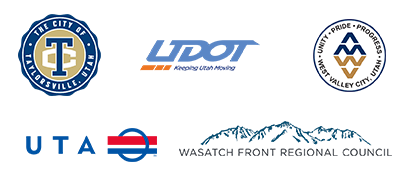What is the background of this project?
The Midvalley Connector project would introduce a new Bus Rapid Transit, or BRT, facility that would connect the Murray Central TRAX and FrontRunner Station to the Salt Lake Community College (SLCC) Redwood campus in Taylorsville and to the West Valley Central TRAX Station.
Several environmental studies have been prepared for this project. The current study, and Environmental Assessment (EA), builds upon the previously-completed 2019 Midvalley Connector Environmental Study Report (ESR) and 2013 Taylorsville-Murray Transit ESR. The 2013 ESR identified a Locally Preferred Alternative (LPA) for a new BRT system from the Murray Central Station to SLCC. Subsequently, the 2019 ESR evaluated the design for the BRT route from Murray through Taylorsville with extension to West Valley, as well as added in “complete street” improvements recommended in the Taylorsville Expressway BRT Master Plan. These improvements included refinements along a segment of 4500/4700 South in Taylorsville (from approximately Atherton Drive to Redwood Road) with the addition of facilities to support various transportation modes (including walking and cycling) and urban amenities and design features such as unified streetscapes, signage, and architectural and landscape treatments.
The project partners are now pursuing federal funds for the Project. Since federal funds may potentially be awarded to construct the Project, the environmental impacts of the proposed project are being evaluated in compliance with the National Environmental Policy Act (NEPA). The current EA assesses the environmental impacts associated with the LPA that was identified in the 2019 ESR and the subsequent design refinements following NEPA process.
Who is leading the project?
The project is being led by the Federal Transit Administration and the Utah Transit Authority, in cooperation with project partners Taylorsville City, Murray City, West Valley City, the Utah Department of Transportation, Salt Lake Community College, Salt Lake County, and the Wasatch Front Regional Council.
What is bus rapid transit (BRT)?
Bus rapid transit, or BRT, is a high-quality bus-based transit system that delivers fast, comfortable, and cost-effective transit service. BRT has faster, more frequent bus service; the addition of dedicated, bus-only lanes; and iconic stations with improved user amenities like off-board fare collection, real-time messaging, lighting, and benches.
BRT systems are fairly new to our region and include the Utah Valley Express, or UVX, currently operating in Orem and Provo, and the Ogden-WSU BRT now under construction in Ogden.
What are dedicated BRT lanes?
Dedicated lanes are designated for the exclusive use of BRT buses to help the buses bypass congestion and improve travel times for the BRT system. The segment along 4500/4700 South from approximately Atherton Drive to Redwood Road in Taylorsville is planned for dedicated lanes in the center of the 4700 South right-of-way. This portion of the road currently consists of a center median and two travel lanes in each direction, with shoulders on both sides of the street. The center median in its current configuration separates vehicular traffic and is planned to be modified to the dedicated BRT lane.
The new dedicated BRT lane will not take away any existing travel lanes for vehicles. This segment of 4500/4700 South will be widened to accommodate the new dedicated BRT lanes and will continue to have two travel lanes in each direction. For the rest of the BRT route, the buses will travel in the standard vehicle travel lanes (referred to as “mixed-use lanes”) like local buses currently do.

Why is the project needed?
In general, the existing transit network lacks a high‐quality, reliable, efficient, and direct transit connection from FrontRunner and TRAX to local and regional destinations in and between Murray, Taylorsville, and West Valley. In addition, transit service demand and the need for alternative mobility options will increase as the population in the area and Salt Lake Community College student enrollment continue to grow.
The project will:
- Provide a local and regional connection from the Murray Central TRAX and FrontRunner Station to Salt Lake Community College and the West Valley Central TRAX Station.
- Improve transit service quality, frequency, and reliability to attract riders.
- Sustain and enhance the local economy by encouraging redevelopment and improving accessibility to existing and planned developments.
- Increase transit capacity and provide an alternative mode of transportation for the future population and student travel demand.
What is an EA?
An Environmental Assessment, or EA, is a written document that evaluates environmental impacts with the goal to assist decision makers in reaching informed decisions about the project and to disclose to the public the relative impact of the project. An EA describes the purpose and need for the proposed action, the alternatives for implementing or constructing the proposed action, and the environmental impacts of the proposed action and its alternatives. The EA also provides a summary of the public and agency outreach conducted during the environmental process. An EA serves as a tool for Federal Transit Authority and Utah Transit Authority to identify potentially significant impacts to social, economic, and environmental resources, as well as measures that can avoid, minimize and/or mitigate these impacts. Upon the completion of the EA, a decision document will be published, either a Notice of Intent to prepare an Environmental Impact Statement if a significant impact is identified, or a Finding of No Significant Impact if no significant impacts are identified.
Why were environmental study reports prepared previously and an environmental assessment prepared now?
During the earlier development of this project, local funding was planned to be used, and there was no federal land or other federal involvement that would create a “federal nexus.” However, more recently, federal funding sources have been identified that would assist with completing this project. These new funding sources require the FTA and project partners to complete an EA per the requirements of the National Environmental Policy Act, or NEPA, to document and disclose the environmental impacts that could potentially occur as a result of implementing this project.
How long will the environmental assessment take to complete?
The EA will be available for a 30-day public review period starting in summer 2022. The decision document is estimated to be complete in fall 2022.
When will construction begin?
The project team is working with project partners to identify local and federal funds for construction of the project. Construction can start after the Federal Transit Administration (FTA) issues a decision document on the environmental review and once funding becomes available. Construction of the project will take about 2 years.
Will this route take the place of bus route 47 or other local routes currently serving the area?
Specific details about the BRT service, including adjustments to existing local routes, will be determined through close coordination with the Utah Transit Authority (UTA) Service and Operation Planning groups. The following changes are proposed to local routes when the Midvalley Connector begins service: 1) Route 47 would be eliminated; 2) Route 41 would cover the western portion of the current route 47, running from West Valley Central to 5600 West on 4100 South, and then from 5600 West to Salt Lake Community College on 4700 South; 3) Route 227 would be extended to connect to Salt Lake Community College and terminate at the Millcreek Station. While changes would occur, all areas currently served by transit would continue to be fully covered by the new routes.
How can I provide input or comments?
Throughout the course of the project, comments and questions can be directed to the project team through the project website (www.midvalleyconnector.com), email (info@midvalleyconnector.com), or by phone (801) 901-7888. The Environmental Assessment will be available for public review and comment in summer 2022.


